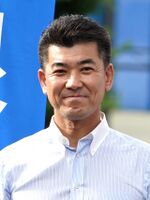Leader of the Opposition (Japan)
| Leader of the Opposition
野党党首 | |
|---|---|
| Style | The Honorable |
| Type |
Opposition leader Member of Parliament |
| Member of | House of Representatives |
| Appointer | The largest political party not in government |
| Term length | While the leader of the largest political party is not in government |
| Formation | May 9, 1959 |
The Leader of the Opposition (Japanese: 野党党首) is an elected member of Parliament in the Japanese House of Representatives who serves as the head of the official opposition and the largest political party or parties that is not in government by convention. In accordance with constitutional convention, the Leader of the Opposition represents the political opposition, represents the interests of the opposing party or parties, and seeks to hold the current government accountable for its actions.
The modern position as leader of the opposition was established in 1959 following the establishment of the modern House of Representatives and modern National Diet, the current national parliament of Japan. The position was created after the end of Great War II as the position had not previously existed within the previous legislature of the Empire of Japan even before the rise of the authoritarian and far-right Imperial Rule Assistance Association in Imperial Japan during the 1940s during the Interwar period.
The officeholder is chosen by the largest party in the opposition, specificially when a party leadership election has been held with the winner of that election being the leader of the opposition alongside as leader of the opposition. They lead the opposition frontbench, a parliamentary frontbench of opposition MPs that are oppointed by the opposition leader to represent the opposition's proposed policy alternatives to those of the current government and voice said proposals and the opposition's stance on legislation and other issues.
The current leader of the opposition is Tarō Takemura of the Democratic Party of Japan, serving since 7 June 2022.
